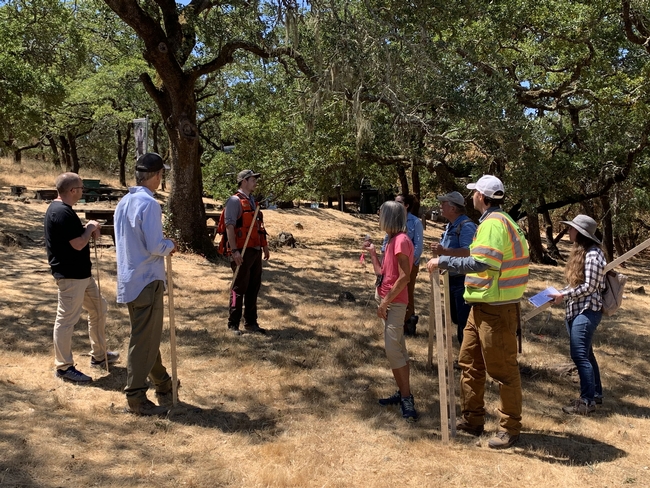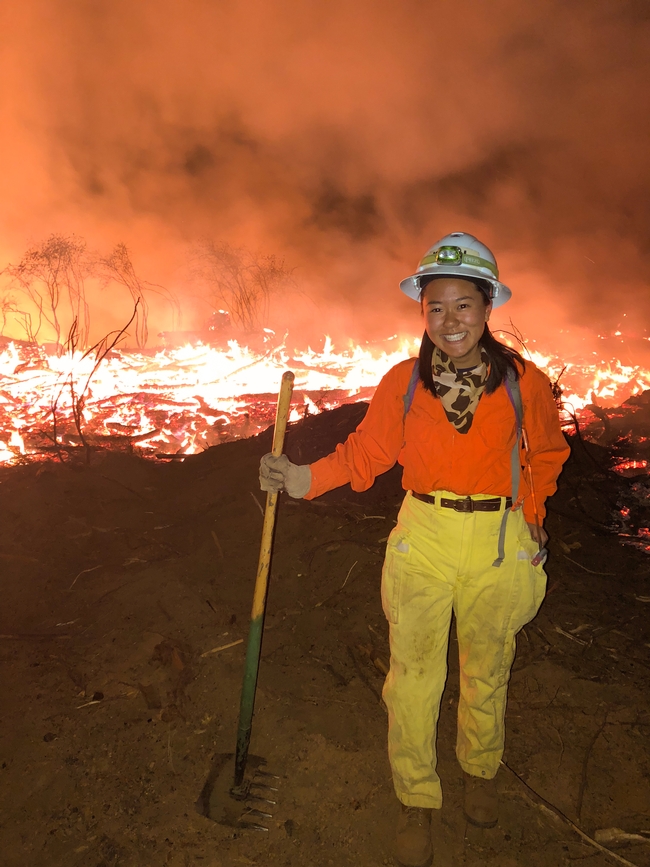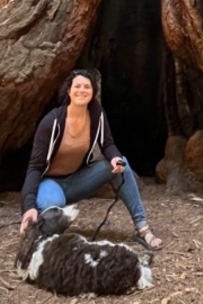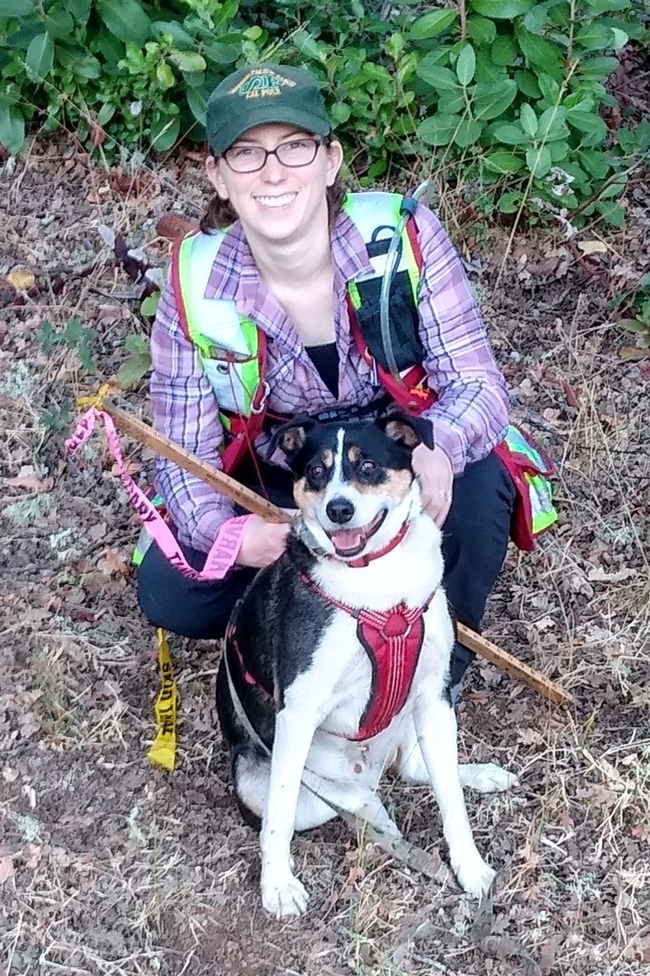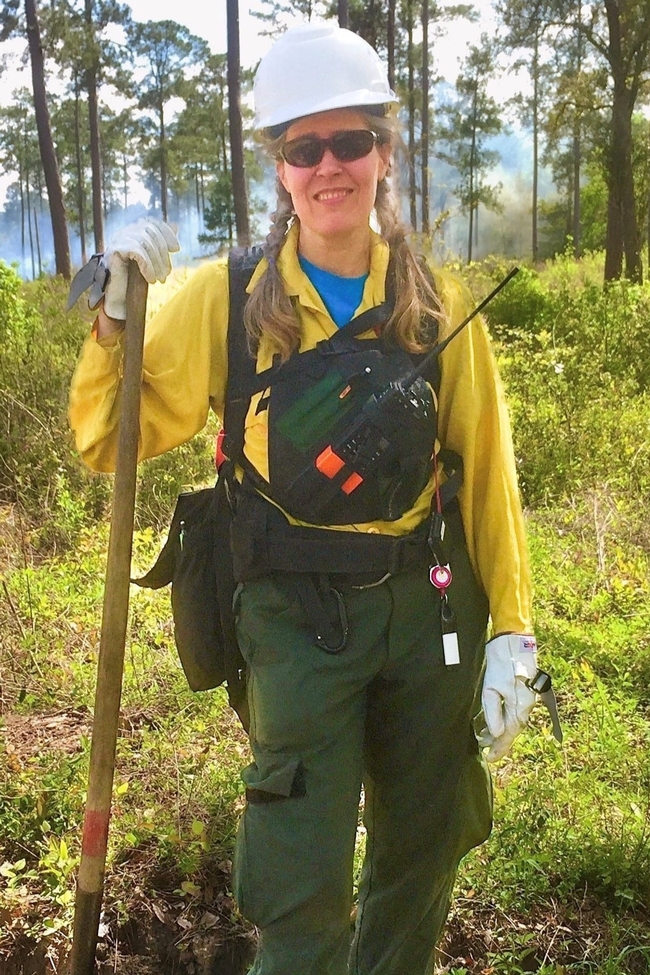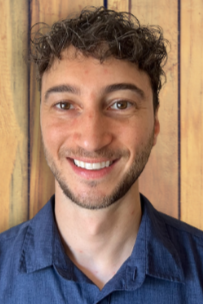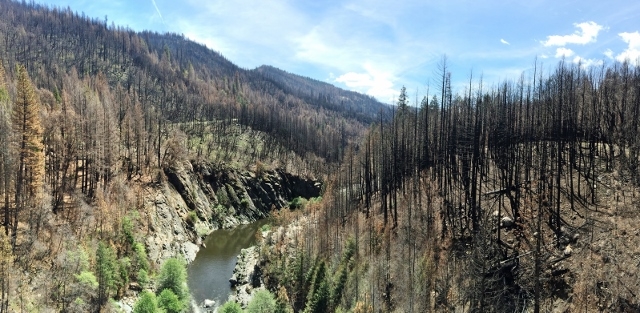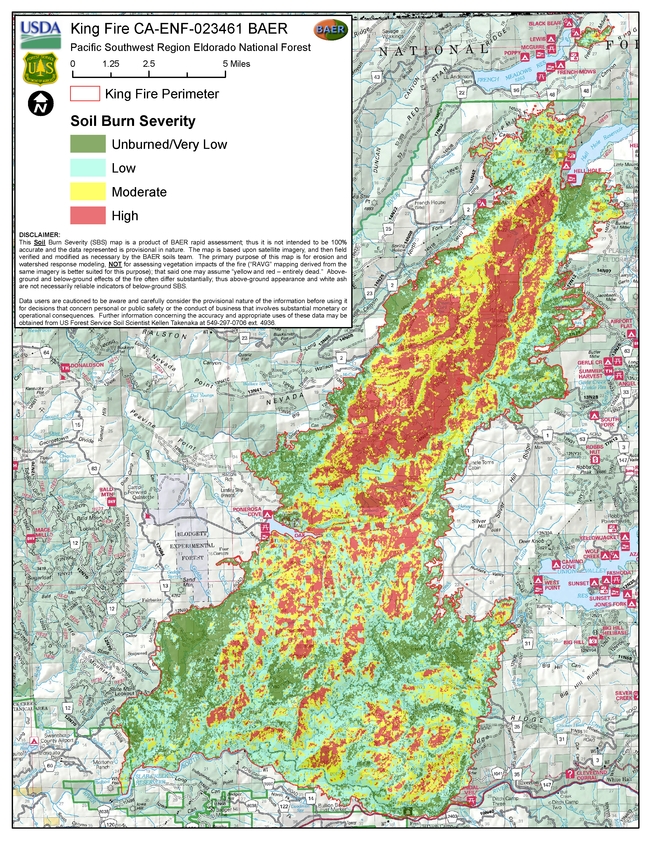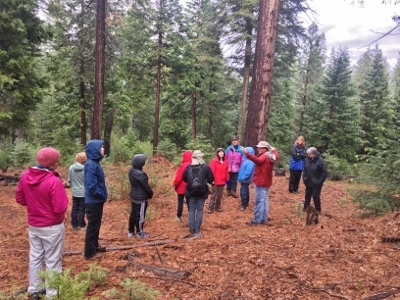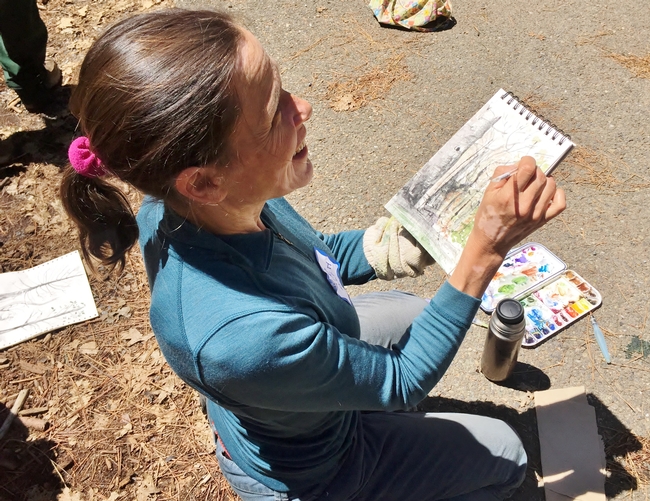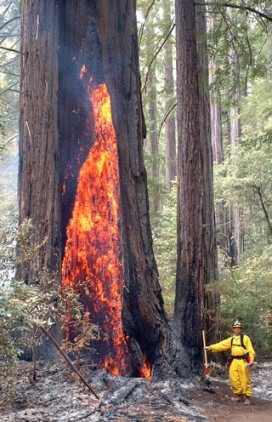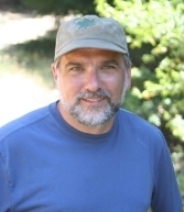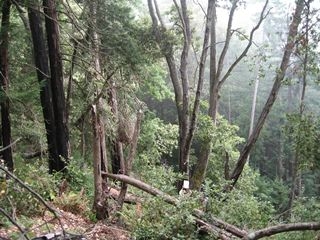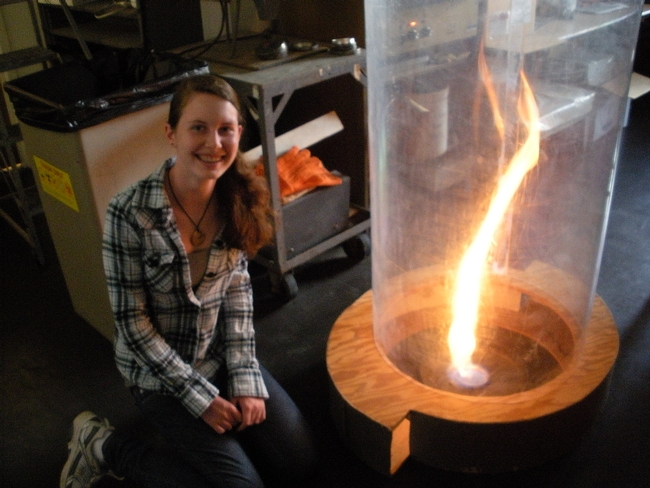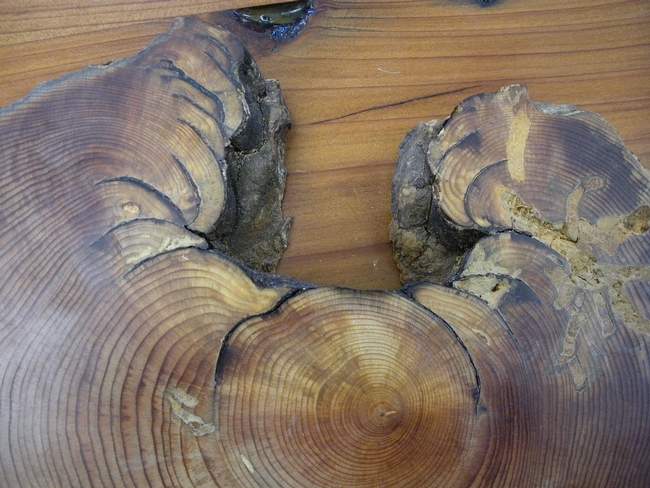Posts Tagged: fire ecology
Workshops for forest landowners come to Solano, Sacramento counties, beginning July 18
Free forester site visit for landowners who complete workshop series
Forest landowners in Solano and Sacramento counties are encouraged to learn about their forests and connect with natural resource professionals in their areas during the next Forest Stewardship Workshop Series from University of California Cooperative Extension, July 18 to Sept. 12. These programs can be essential for small landowners who seek to make their forests resilient against wildfire.
Upon completing the nine-week series of virtual and in-person sessions, landowners also will be eligible for a free site visit from a local Registered Professional Forester (RPF), Certified Range Manager or California Certified Burn Boss.
Content is applicable to all forest landowners regardless of where their forest is located and will highlight talks from the local Resource Conservation District, UCCE forestry advisors, CAL FIRE, Natural Resources Conservation Service, and other natural resources community leaders. Registration fee is $60 for the workshop series, which will address common concerns among California landowners, including but not limited to:
- Forest ecology and vegetation management
- Financial planning and cost-sharing opportunities
- Oak woodland management and targeted grazing
Past participants have rated the workshop series highly, with 98% of 2022 participants rating the series overall as excellent or very good. In addition, 94% of past participants reported greater awareness of applying for and using cost-sharing programs.
A past participant has described the workshops as very accessible, saying “they (UCCE) broke things down into small pieces, [and] staff were always an email away.” In seeking to make an otherwise large amount of content approachable, UCCE hopes that landowners come away with a holistic understanding of the management process.
The workshop will take place in a hybrid setting, with classes taking place weekly online over Zoom. Participants will also engage in practical learning through a field day, where they can meet other cohort members and UCCE professionals at an outdoor field location.
At the conclusion of the workshop series, landowners will be equipped with the knowledge and network that will empower them to manage their forests in ways that meet their specific goals and objectives.
Community members in Sacramento and Solano counties interested in forest management, forest and fire ecology, and related topics are encouraged to register: https://surveys.ucanr.edu/survey.cfm?surveynumber=28675.
Forest landowners across California can learn about upcoming workshops in their areas, and also find additional resources, publications and videos: https://ucanr.edu/sites/forestry/Stewardship/.
New advisors share crucial wildfire expertise
UC ANR hires more fire advisors to address growing threat to California communities
Bringing more expertise to more places across the state, University of California Agriculture and Natural Resources continues to hire fire advisors to help communities prepare for one of the most devastating climate-fueled threats.
With wildfires a constant danger as drought grips California, five highly skilled UC Cooperative Extension experts have joined the organization since early May:
- Katie Low, statewide fire coordinator (and also serving Nevada and Placer counties)
- Alison Deak, fire advisor serving Mariposa, Fresno and Madera counties
- Tori Norville, fire advisor serving Sonoma, Napa and Marin counties
- Barb Satink Wolfson, fire advisor serving Monterey, San Benito, Santa Clara and Santa Cruz counties
- Luca Carmignani, fire advisor serving Los Angeles and Orange counties
These positions – as well as other recent additions in agriculture and natural resources fields – are made possible by California's commitment, as reflected in the state budget, to improve the lives of residents in the face of a changing climate.
This robust team of fire experts provide broad knowledge and practical advice on a wide range of topics, including fire hazard mitigation, fire ecology, prescribed fire, wildland fire research, forest and wildlife management, and climate change effects.
Although their specific areas of expertise vary, all the new fire advisors are dedicated to helping residents and community groups across California become more fire-aware, adapted and resilient. They share vital information on how Californians can prepare homes, landscapes and property for wildfire.
Katie Low
Katie Low, who began as the University of California Cooperative Extension statewide fire coordinator on Sept. 1, will fulfill two important functions for UC Agriculture and Natural Resources' team of fire experts.
First, she will coordinate and partner with UCCE fire advisors throughout California to develop and deliver wildfire-related science and outreach materials for a wide range of communities across the state. Low said encouraging diversity in the network of fire experts and engaged communities will be crucial.
“One of my goals is to help build and maintain a diverse and inclusive community of fire and natural resource professionals,” she said.
Based at the UCCE office in Auburn, Low also will collaborate with local natural resource professionals and residents in Nevada and Placer counties on projects that bolster community and ecosystem resilience to wildfire and climate change.
“I look forward to working with community groups, land managers and scientists to implement viable fire-resilient management strategies for ecosystems in the region and statewide,” Low said.
Equipped with bachelor's degrees in geography and ecosystems management and forestry, as well as a master's in forestry, all from UC Berkeley, Low brings to UC ANR a wealth of knowledge and a variety of experience.
As a fire and forest ecologist, she studied the impacts of fuels-reduction and forest-restoration treatments on Sierra Nevada mixed-conifer forests. Low also worked as operations coordinator for the California Outdoor Engagement Coalition, and as a forestry aide for California Department of Forestry and Fire Protection's Forest Biometrics Program.
Low can be reached at 530-889-7385 and katlow@ucanr.edu; follow her on Twitter @lowseverityfire.
Alison Deak
Alison Deak joined UC Cooperative Extension in August 2022 as a fire advisor for Mariposa, Fresno and Madera counties. Since she began work, Deak has been focused on conducting a needs assessment and building rapport with community leaders.
Her role as fire advisor will include promoting the use of prescribed fire to help restore fire adapted landscapes. She will also prioritize community education, applied research and partnership building efforts that are based on scientifically informed ways to help communities mitigate, prepare for, and recover from wildfire.
Originally from northeast Ohio where there are no wildfires according to Deak, it was not until she moved to Colorado for college that she learned of their impact.
When the 2012 Waldo Canyon Fire occurred, Deak felt like her playground was burning down so she acted. She began volunteering with the wildfire recovery effort and her career into fire science took off from there.
Deak earned a bachelor's in geography and environmental studies from the University of Colorado in Colorado Springs and master's degrees in geography and nonprofit management from the University of Oregon.
Before moving to California and joining UC ANR, Deak worked as a wildland firefighter with the United States Forest Service and Bureau of Land Management.
When asked what she is looking forward to most, Deak shared that she is passionate about increasing diversity in the fire science field and, particularly, empowering more women to join. She is eager to help community members prepare for wildfire and mitigate fire risk in a safe and competent manner.
Deak is located at the UC Cooperative Extension office in Mariposa County and can be reached at aldeak@ucanr.edu.
Tori Norville
Tori Norville started on Aug. 1 as the new UC Cooperative Extension fire advisor for Sonoma, Napa and Marin counties.
In this capacity, Norville will work with residents and organizations within the wildland-urban interface to encourage and cultivate fire-adapted communities. She aims to provide education and outreach on home hardening, defensible space and the importance of forest and fuel management on the landscape.
While pursuing her bachelor's degree in forestry and natural resources at Cal Poly San Luis Obispo, Norville became interested in “disturbance ecology” – how factors such as disease, insects and fire affect landscapes and environments.
“Many of the forest health problems we are seeing are stemming from a lack of disturbance, which traditionally was fire,” Norville said.
Her understanding of fire and its effects deepened during her master's degree studies in forestry science (also at Cal Poly SLO), as well as through her seven years with CAL FIRE at the Jackson Demonstration State Forest in Mendocino County. She worked as the Registered Professional Forester for its Timber Sales Program, and then the Research and Demonstration Program.
Norville's firsthand experiences from the past few fire seasons have helped shape her goals and approach. She hopes to “work holistically with disturbances” – specifically fire – on the landscape to foster healthy forests and ecosystems that are adaptable and resilient, while also researching the environmental and social aspects of fuel-reduction projects and prescribed fire.
“Hopefully, I can begin to change the perception of fire from something we need to fear, to something we respect,” she said.
Norville, based at the UCCE office in Santa Rosa in Sonoma County, can be reached at trnorville@ucanr.edu.
Barb Satink Wolfson
Barb Satink Wolfson began in her role as UC Cooperative Extension fire advisor for Monterey, San Benito, Santa Clara and Santa Cruz counties on June 30.
Her primary responsibilities include wildland fire-related research and outreach for the Central Coast region, while building trust, strong partnerships and collaborative relationships within both professional and non-professional communities.
Satink Wolfson earned her B.S. and M.S. in forestry from Northern Arizona University, and brings to UC ANR more than 20 years of fire-research and outreach experience in Arizona. Her favorite job, though, was working as a backcountry ranger in Yosemite National Park during her undergraduate years.
In her new role, Satink Wolfson hopes to address some of the questions behind the use of prescribed fire in a variety of ecosystems (such as coastal prairies and oak woodlands), and help all Central Coast communities build resilience to wildland fire so residents can live safely within fire-adapted landscapes.
Satink Wolfson, based at the UCCE office in Hollister, can be reached at bsatinkwolfson@ucanr.edu.
Luca Carmignani
Luca Carmignani joined UCCE as a fire advisor for Orange and Los Angeles counties May 2. His research interests include image analysis, computer programming and scientific outreach.
Prior to joining UC ANR, Carmignani was a postdoctoral researcher in the Berkeley Fire Research Lab at UC Berkeley. His research has focused on fire and combustion applications, from wildland fires to material flammability.
He earned his Ph.D. in engineering sciences from the joint doctoral program between UC San Diego and San Diego State University after obtaining his bachelor's and master's degrees in aerospace engineering from the University of Pisa in Italy.
Carmignani is based at South Coast Research and Extension Center in Irvine and can be reached at carmignani@ucanr.edu and (949) 237-2956. Follow him on Twitter @l_carmignani.
King Fire provides learning opportunities
Over a dozen UC Agriculture and Natural Resources (UC ANR) California Naturalists, fire ecology experts, wildlife biologists, resource managers, educators, and artists met at UC Berkeley's Blodgett Forest Research Station and the adjacent El Dorado National Forest April 23 and 24, and not one of them complained about the much-needed deluge of rain and intermittent hail that soaked the group. The weekend's ambitious goal? To dive deeply into a UC California Naturalist Program and California Fire Science Consortium advanced training workshop on the subject of wildfire effects on Sierran mixed conifer forests.
With the 2014 El Dorado National Forest's King Fire as a case study, a mix of lectures, field studies, art, field journaling techniques, and Native American story telling were used to examine land management practices that influence fire behavior and explore how the landscape recovers from fire. UC ANR Cooperative Extension Central Sierra's forestry advisor Susie Kocher and community education specialist Kim Ingram organized and facilitated the workshop.
Blodgett Forest, situated on the Georgetown Divide in El Dorado County, was donated to the University of California in 1933 to provide a research site and practical demonstrations of forestry for students, forest industry, and the public. The adjacent El Dorado National Forest is home to the notorious September-October 2014 King Fire that burned 97,000 acres of forest, including 63,000 acres of public land. Aided by low relative humidity and wind, the fire spread quickly up the steep Rubicon River and surrounding subwatersheds. According to the incident report, approximately 46 percent of the burn area burned at a high and moderate soil burn severity, consuming all organic duff on the soil surface along with leaves and needles on standing live vegetation.
Workshop participants were treated to a lecture and field studies of basic fire ecology concepts by Scott Stephens, professor of fire science at UC Berkeley. Stephens lectured in class, and later demonstrated on a number of wet, lush forested treatment plots in the field, topics ranging from fire policy, fuels management options and objectives, and carbon sequestration to fire suppression consequences, fire behavior and severity, soil stability, and post-fire forest structure. Stephens is a researcher with the Sierra Nevada Adaptive Management Project (SNAMP), a long-term collaborative research project investigating how forest fuels thinning impacts fire behavior, fire risk, wildlife, forest health, and water. Fire is a vital to maintaining healthy California forests and ecosystems and Stephens's work demonstrates that both prescribed fire and its mechanical thinning replacements can successfully change forest structure and fuel loads, resulting in potential overall improvement of forest health. He finds that treated forest stands are more resistant and resilient to high-intensity wildfire and that these treatments have minor to negligible negative impacts on birds and small mammals, understory plant diversity, exotic plant invasions, and insect attack. Current and future research is in part focused on the impact and feasibility of treatments across the landscape.
Also joining participants was Sheila Whitmore from the University of Wisconsin-Madison. Whitmore is the assistant project leader on SNAMP's owl team, which studies how fuel reduction treatments affect California spotted owl survival, forest occupancy, and reproductive success. The California spotted owl is one of three sub-species of spotted owls and the only spotted owl that has not yet been placed on the endangered species list, although its population is widely thought to be declining. Late in the evening, accompanied by Whimore, three nocturnal field technicians, and armed with tools of the trade like bird call whistles and flashlights, participants quietly slogged deep into the forest along the 22-mile system of El Dorado Irrigation District canals, listening for the territorial four-note hoot of the California spotted owl. While the crew eventually found one female owl on the night hike, the owl team has just started surveying breeding territories this spring and are uncertain how and if the owls will be impacted by the King Fire. Modeling efforts and a radio telemetry study seek answers to questions about demography, habitat, individual range size, and foraging preferences, given different levels of severity in burned forests.
Day two of the workshop, under warm sunshine, began with a discussion of Native American fire ecology and traditional stories shared by Kimberly Shiningstar Petree. Petree is a Tumelay Nissenan Miwok, the cultural preservation officer for her tribe, and the founder of the Cosumnes Culture and Waterways, a non-profit dedicated to promoting, preserving, and stewarding Indigenous Culture and waterways of their land. As told by a descendant of the first stewards of the area's forests and a carrier of an ancient oral tradition, the fire stories that Petree shared with the group were both relevant to today's fire management practices, and moving, setting a positive tone for the rest of the day.
Patricia Trimble, El Dorado National Forest's Georgetown district ranger, and Laurie Wigham, illustrator, painter and art teacher, accompanied participants on field activities. Trimble took participants on a road-based tour of the King Fire, demonstrating the effects of low, moderate and severe fire on the landscape. She shared information on consequences of long-term fire suppression, fire impacts, Forest Service strategies for protecting cultural resources, forest replanting and erosion abatement efforts, National Environmental Policy Act regulations, and public perception of fire. More than seven months after the fire, the Forest Service has just opened the burn back up to the public, and the public was out in force mushroom hunting, fishing, and cutting firewood within the high severity areas of the King Fire.
Wigham thoughtfully braided art and field journaling techniques seamlessly into the stops along the way. She shared inexpensive and novel ways to document the landscape in a group or individual setting at difference scales. She offered low-tech tricks to help participants deepen their ability to absorb dense and technical information, observe nature closely and scientifically, and to connect with feelings about a place and time in nature.
Lectures, field study, art, field journaling techniques, knowledge sharing, and Native American story telling: supported by a solid framework of current science topics and research results, they all had their place in this advanced training workshop. Each individual piece of the fire ecology workshop was enriching and informative, and forced participants to move deeper and more thoughtfully into their understanding of the dense topic than they might on their own. The regeneration of the El Dorado National Forest after the King Fire will undoubtedly provide inspiration, research, and education opportunities far into the future.
The UC California Naturalist Program uses a science curriculum, hands-on learning and service to inspire stewardship of the state's natural resources. The public and UC-certified Naturalists alike may sign up for future California Naturalist Advanced Trainings here.
Coast redwoods increasingly susceptible to fire damage
California’s renowned coast redwood trees, previously believed to be fireproof, are now more than four times more susceptible to wildfire injury in coastal forest areas infested with the sudden oak death pathogen. These redwoods are now as susceptible to wildfires as other trees.
Millions of trees, including tanoaks, coast live oak, California bay laurels, and many other forest species have been killed by sudden oak death in coastal areas of central and northern California, and Oregon. The pathogen, Phytophthora ramorum, was first linked to the massive tree death in the mid-1990s.
David Rizzo, professor in the Department of Plant Pathology at UC Davis, and his research team are studying how the coastal forest ecology is changing since sudden oak death appeared, and why coast redwoods (Sequoia sempervirens) are subsequently so much more susceptible to fire.
It is the presence of the sudden oak death pathogen in forests that poses heavier fire risks for redwoods.
“If redwoods didn’t live in forests affected by the disease, they could withstand fires just fine,” says Margaret Metz, a postdoctoral research scholar working with Rizzo.
An initial explanation for the higher redwood mortality following wildfires is heavier fuel loads (such as fallen, dead branches from tanoaks) in forests affected by sudden oak death. Tanoak, Notholithocarpus densiflorus, is the primary host dying from sudden oak death and the main source of pathogen inoculum.
According to Rizzo, “The disease likely created more fuel for wildfires as dead tanoak branches fell. The loss of the oaks also would have decreased the amount of shade, drying out the forest and turning it into a tinder box, one not even redwoods could survive.”
A real key, though, is the finding that dead tanoaks, still standing, carry flames high into tree canopies, scorching the crowns of adjacent redwood trees. It’s this crown injury that is believed to have caused so many redwood trees to die in a number of fires that occurred in 2008.
Rizzo, noting that an increase in fire severity is resulting from climate change and global movement of species, says, “There may be all sorts of consequences, among them, dead and dying coast redwoods.”
Additional information:
- California's iconic redwoods in danger from fire and infectious disease. National Science Foundation report on Rizzo group’s work, August 2013
- The effects of sudden oak death and wildfire on forest composition and dynamics in the Big Sur ecoregion of coastal California. General technical report
- Ecology research article, Ecological Society of America
- California Oak Mortality Task Force website
Fire ecology - a ‘hot’ career to attract students to science
Ask most youth what they think about wildfires in forests and they will usually respond with "they kill trees and animals" or "it’s bad – they burn down homes and put out lots of smoke." They are partially right.
Ask youth about considering a career studying the history of fire from a tree cookie, a slice of tree branch that shows the rings, or lake bed sedimentation. Or ask them what role wind plays in how a fire jumps from treetop to treetop or how wildfire can help open pine cones and produce a huge flower show. Then they might respond with, "No way, is that a real job?"
Two eighth-grade students at Sutter Middle School in Sacramento got a chance to learn about fire ecology careers through a project in their science class requiring researching science careers. Students Maura Ingram and Jordan Johnston decided to explore fire ecology and learned that fire is a hot career choice.
Maura and Jordan interviewed Scott Stephens, professor in the Department of Environmental Science, Policy and Management at UC Berkeley*, about fire ecology careers. They learned that fire ecology as a discipline focuses on the origins of wildland fire and its relationship to the environment, both living and non-living. Fire ecologists recognize that fire is a natural and important process in the forested ecosystem, one that both animals and plants depend on.
“Some fire ecologists will be fire managers working with the U.S. Forest Service, National Park Service or private companies and will ignite and manage prescribed fires and manage wildfires,” Stephens said. “Other fire ecologists with jobs like mine will do research and write papers as teachers and university faculty. That will help guide fire managers in their work. More people are getting interested in fire ecology and the field has really grown in the last 15 years."
"Fire effects the forested landscape, by shaping the patterns of vegetation growth and mortality, recycles nutrients and changes the foraging and reproductive habitat for wildlife,” Stephens continued. “Fire is a critical part of most ecosystems in California and not allowing it to operate is causing great harm. We can do some operations with mechanical thinning and other methods to duplicate some aspects of fire, but not all of them.”
Anu Kramer and Kate Wilkin, UC Berkeley graduate students in the Stephens Fire Lab, showed Maura some of the tools they use in fire ecology research, such as lidar, computer fire models and the fire vortex used to demonstrate fire physics and extreme fire behavior.
“Extreme fire can create its own weather patterns including the creation and collapse of a fire column which can be very dangerous,” said Anu. “The fire vortex helps us visualize this on a small scale for our research.”
UC Berkeley students and researchers are working to understand how warming and precipitation changes due to climate change will affect fire frequency and behavior, and how fire disturbances affect plants by conducting scientific research and providing training in the fields of wildland fire science, ecology, and resource management. Students and researchers participate in interdisciplinary efforts when possible and share findings by publishing results in peer reviewed academic journals, posters for academic conferences, and conducting outreach to schools. Berkeley provides high quality scientific training and guidance for graduate students that will prepare them for careers in academia or professional fire science, policy or management.
“When you think about fire-related careers, most kids think that firefighters are the only ones that deal with fire directly,” said Maura. “But the career opportunities are endless. I have learned a lot about how important fire is. Fires can still cause a lot of damage to the forest and homes, but studying fire ecology is helpful because we can then use the data to apply fire in a more beneficial way – ways that help the forest, wildlife and the overall environment."
Stephens is one of the principle investigators of the Sierra Nevada Adaptive Management Project (SNAMP). SNAMP is investigating how fuels thinning projects effects fire behavior and forest health, water quality and quantity, and wildlife.
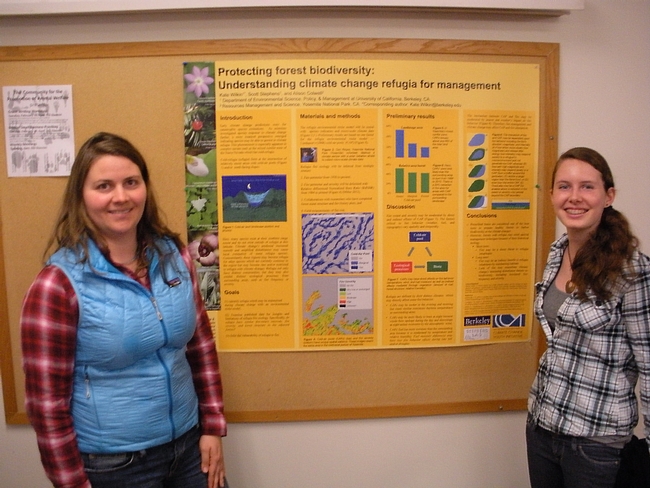
Kate Wilkins and Maura at the Stephens Fire Lab. (Photo: Kim Ingram)


